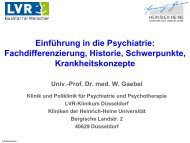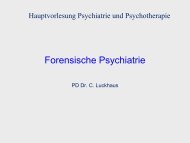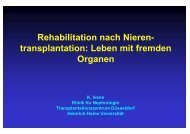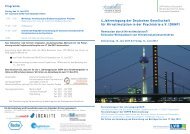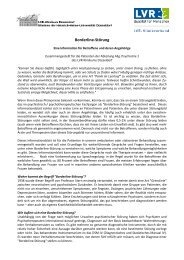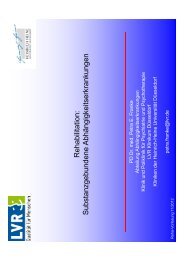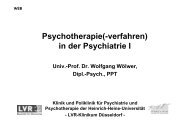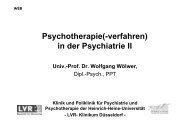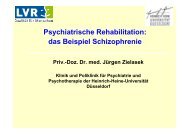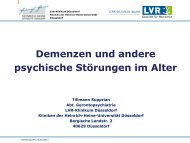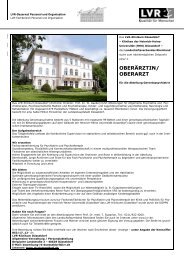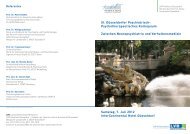LVR-Klinikum Düsseldorf Hospital of the Heinrich-Heine University ...
LVR-Klinikum Düsseldorf Hospital of the Heinrich-Heine University ...
LVR-Klinikum Düsseldorf Hospital of the Heinrich-Heine University ...
Create successful ePaper yourself
Turn your PDF publications into a flip-book with our unique Google optimized e-Paper software.
<strong>LVR</strong>-KLINIKUM DÜsseLDORF – hOsPITaL OF The heINRIch-heINe UNIVeRsITY DÜsseLDORF<br />
<strong>Düsseldorf</strong>, <strong>the</strong> hypo<strong>the</strong>sis was investigated that several<br />
atypical antipsychotic drugs influence adipogenesis at a<br />
cell-biological level. Initial results show that olanzapine and<br />
risperidone enhance <strong>the</strong> differentiation and lipid storage<br />
<strong>of</strong> <strong>the</strong> pre-adipocytes. However, aripiprazole inhibits<br />
differentiation. This effect was also found in patients<br />
receiving co-medication with clozapine and aripiprazole.<br />
Lithium chloride had no effect on adipogenesis.<br />
Investigations into <strong>the</strong> molecular pathophysiology <strong>of</strong><br />
neurogenesis during <strong>the</strong>rapy with psychotropic drugs<br />
U. Henning and C. Luckhaus<br />
Project period: from 2005<br />
Financing: Department’s research budget<br />
Neurobiological concepts <strong>of</strong> <strong>the</strong> pathogenesis <strong>of</strong> depression<br />
state that neurogenesis in <strong>the</strong> hippocampus may play<br />
a central role in improving <strong>the</strong> disease course. Animal<br />
experiments could show that an increased serotonin level<br />
activates neurogenesis in <strong>the</strong> dentate gyrus. Contrarily,<br />
stress leads to inhibition. In addition, neurogenesis can be<br />
stimulated through drug components (such as lithium). It<br />
is supposed that <strong>the</strong>se agents enhance <strong>the</strong> production <strong>of</strong><br />
growth factors by regulating <strong>the</strong> expression <strong>of</strong> transcription<br />
factors. In order to test drug effects on neurogenesis in<br />
<strong>the</strong> CNS, we would like to establish a murine in vitro cell<br />
model composed <strong>of</strong> hippocampal neurones and glial cells.<br />
Of specific interest is <strong>the</strong> question <strong>of</strong> how far astrocytes<br />
contribute to <strong>the</strong> metabolisation <strong>of</strong> psychotropic drugs<br />
and <strong>the</strong>reby influence <strong>the</strong> activity <strong>of</strong> drug components. For<br />
initial pilot investigations, we produced primary cell cultures<br />
70<br />
from hippocampus neurones from adult mice in <strong>the</strong> animal<br />
experiments section <strong>of</strong> <strong>the</strong> <strong>Heinrich</strong>-<strong>Heine</strong> <strong>University</strong>,<br />
<strong>Düsseldorf</strong>, and cultivated <strong>the</strong>se cells in <strong>the</strong> department’s<br />
own research laboratory. In order to increase <strong>the</strong> purity and<br />
yield <strong>of</strong> <strong>the</strong>se native cells and, in particular, to conserve <strong>the</strong><br />
vitality <strong>of</strong> <strong>the</strong> neurones and astrocytes in long-term culture,<br />
neurone and glial cells from neonatal mice were used in<br />
cell culture with <strong>the</strong> support <strong>of</strong> <strong>the</strong> Institute for Neuroand<br />
Sensory Physiology <strong>of</strong> <strong>the</strong> <strong>Heinrich</strong>-<strong>Heine</strong> <strong>University</strong>,<br />
<strong>Düsseldorf</strong>.<br />
The nicotine acetylcholine receptor (nAChR) in<br />
B-lymphoblasts: investigation <strong>of</strong> receptor regulation<br />
during nicotine exposure as a correlation <strong>of</strong> nicotine<br />
addiction in healthy persons vs. persons with<br />
schizophrenia<br />
U. Henning, S. Ferrea, C. Luckhaus<br />
Project period: from 2006<br />
Financing: Research Commission <strong>of</strong> <strong>the</strong> Faculty <strong>of</strong> Medicine<br />
<strong>of</strong> <strong>the</strong> <strong>Heinrich</strong>-<strong>Heine</strong> <strong>University</strong>, <strong>Düsseldorf</strong><br />
Secondary illnesses <strong>of</strong> nicotine dependence are <strong>the</strong> most<br />
frequent causes <strong>of</strong> premature death in high-income<br />
countries, so that early diagnosis and targeted <strong>the</strong>rapies <strong>of</strong><br />
nicotine dependence represent a significant future target.<br />
The biological mechanisms <strong>of</strong> nicotine dependence are,<br />
however, still little understood, although genetic disposition<br />
factors apparently play a considerable predisposing<br />
role. The nicotine dependence rates <strong>of</strong> around 80% in<br />
individuals with schizophrenia are clearly higher than<br />
in <strong>the</strong> population in general (20-30%). Joint biological<br />
Microscopy <strong>of</strong> cell cultures in a<br />
micro-electrode array



